气体检漏仪—用户指南
气体检测仪操作说明书
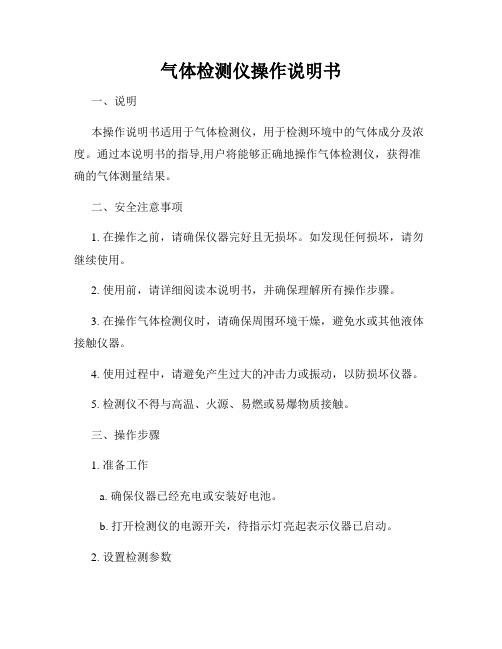
气体检测仪操作说明书一、说明本操作说明书适用于气体检测仪,用于检测环境中的气体成分及浓度。
通过本说明书的指导,用户将能够正确地操作气体检测仪,获得准确的气体测量结果。
二、安全注意事项1. 在操作之前,请确保仪器完好且无损坏。
如发现任何损坏,请勿继续使用。
2. 使用前,请详细阅读本说明书,并确保理解所有操作步骤。
3. 在操作气体检测仪时,请确保周围环境干燥,避免水或其他液体接触仪器。
4. 使用过程中,请避免产生过大的冲击力或振动,以防损坏仪器。
5. 检测仪不得与高温、火源、易燃或易爆物质接触。
三、操作步骤1. 准备工作a. 确保仪器已经充电或安装好电池。
b. 打开检测仪的电源开关,待指示灯亮起表示仪器已启动。
2. 设置检测参数a. 通过仪器的菜单按钮进入设置界面。
b. 使用仪器提供的按键或旋钮选择相应的检测参数,如气体类型、测量范围等。
c. 确认设置后,保存并退出设置界面。
3. 进行气体检测a. 将仪器的探头放置于待检测的气体区域,确保探头与气体充分接触。
b. 静待几秒钟,待仪器稳定后,观察仪器显示屏上的测量结果。
4. 结束检测并关闭仪器a. 检测完成后,将探头离开气体区域。
b. 关闭仪器的电源开关。
四、维护与保养1. 保持仪器干燥:在使用完毕后,用干净的软布轻轻擦拭仪器表面,确保无水或其他液体残留。
2. 避免仪器受损:在存储或携带仪器时,应放置在防尘盒或防震包中,避免受到冲击、振动或磨损。
3. 定期校准:为了保证测量结果的准确性,建议每三个月进行一次校准操作。
请参考仪器的校准说明书进行操作。
4. 防止仪器过热:长时间使用后,仪器可能会产生高温,请避免将仪器放置在易燃或易热物体上。
五、故障处理1. 无法正常启动:请检查电池电量是否耗尽,若是,请充电或更换电池后再次尝试。
2. 显示屏无法显示:请检查连接是否正常,以及仪器是否处于正确的工作模式。
3. 测量结果异常:请确认仪器是否正确设置了测量参数,并保证仪器与待检测气体充分接触。
氦气检漏仪操作方法

氦气检漏仪操作方法
氦气检漏仪是一种常用的气体检测仪器,用于检测气体泄漏。
下面是一般的氦气检漏仪操作方法:
1. 准备工作:确认氦气检漏仪内部的氦气供应充足,并确保仪器与气源(通常是氦气罐)连接良好。
2. 打开氦气供应:打开氦气检漏仪上的气源开关,让氦气进入仪器。
3. 设置检测灵敏度:根据需要,使用仪器上的调节钮或菜单设置灵敏度。
如果需要更高的灵敏度,可以选择较低的数字或更窄的范围。
4. 目标定位:将氦气检漏仪靠近要检查的目标区域,使用仪器上的探头或喷嘴对准目标区域。
5. 开始检测:按下仪器上的检测按钮或触发器,开始释放氦气。
仪器将开始检测周围空气中的氦气浓度,并显示结果。
6. 观察仪器显示:观察仪器上的指示灯、数字显示或屏幕,以确定是否检测到气体泄漏。
一般情况下,如果检测到泄漏,仪器会发出声音或显示相关警告。
7. 确认检测结果:如果仪器显示检测到了泄漏,可以通过改变仪器位置或调整
灵敏度来定位泄漏源的具体位置。
8. 关闭氦气供应:检测完成后,关闭气源开关,停止供氦。
9. 清洁和存储:清洁仪器的外壳和探头,将仪器存放在安全干燥的地方,避免物品压迫或受潮。
请注意,以上仅为一般操作步骤,具体操作方法可能会因仪器型号和制造商的不同而略有差异。
因此,在使用氦气检漏仪之前,最好阅读并按照制造商提供的操作手册进行操作。
同时,确保在操作中遵守相关安全操作规程,并使用个人防护设备,如手套和眼镜。
HDJL-II气体定量检漏仪使用说明书
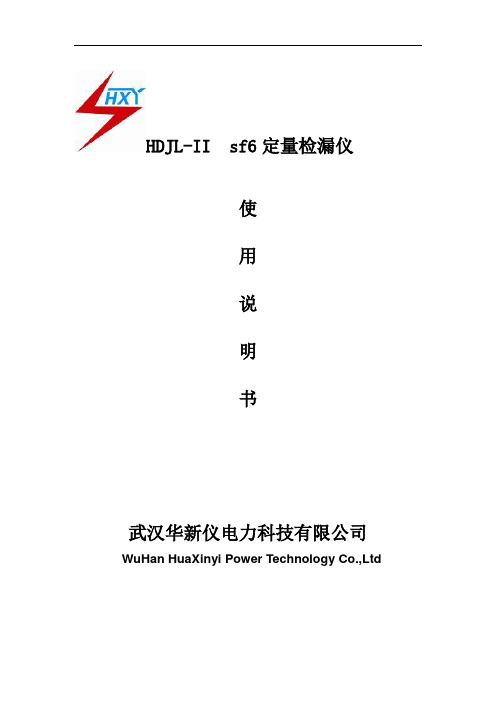
HDJL-II sf6定量检漏仪使用说明书武汉华新仪电力科技有限公司WuHan HuaXinyi Power Technology Co.,Ltd重要注意事项:1、开机前必须观测油窗是否已经注油,否则严禁开机, 油位应在油标中心偏上为宜,并观察是否混浊。
加油时应整个拧下油雾过滤器(黑色或蓝色);2、每次开机时应先打开电源开关,待真空泵运转10到15分钟后,(气温低于-10℃时,由于泵油比较粘稠,真空泵需要运转20分钟后),打开(提起)报警电位器;3、液晶显示一个10-199间的数字,表示开机成功。
4、使用时保持探测器进气口清洁;灰尘或油污堵塞时可用干燥棉花球进行擦拭。
5、起辉后,液晶屏显示数字不稳定跳跃时,请耐心等候3-5分钟等待基本稳定后使用;6、该仪器为精密仪器,建议专人保管,专人使用;存放在干燥、干净场所,使用后应及时收起探测器,盖上盖板。
一、用途HDJL-II sf6定量检漏仪是目前 sf6 气体微量泄漏的最理想检验工具和方法。
具有快速、方便、可靠、精确的特点。
二、技术数据1010气体三、结构产品部件布置,如图1、交流AC220V2、交流10A保险丝3、直流0.5A保险丝4、直流电压表5、电源总开关6、探测器开关/报警电位器7、液晶显示屏 8、探测器观察窗 9、进气口10、针阀 11、真空软管 12、油位观察孔(油窗)13、放油孔(放油螺栓)四、操作步骤与使用方法1.从仪器的左侧上面油位观察孔观测真空泵油位,油位应在油标中心偏上为宜;2.插上电源,按下电源总开关,此时可听见电机启动声,直流电压表显示的“40” V直流电压指示,并在探测器液晶显示为“00”;同时取出探测器,将其放置于机箱外;如未听到电机启动声或直流电压表无显示,应检查2.1.电源线是否插妥;2.2.保险丝是否正常;3.真空泵启动10-15分钟后(环境温度低于-5℃应运转30分钟),打开探测器开关/报警电位器,如液晶显示一个10-100之间的任意一个数字,并保持基本稳定时,探测器观察窗有紫色辉光设备可以正常工作;旋转调节报警电位器,使报警扬声器处于合适的状态;由于产品已经进行重大改进,如10秒内无法进入正常工作状态,液晶显示”1” ,只有以下3种情况;3.1.观测探测器头部针阀部位是否有灰尘或油污堵塞;3.2.真空泵油是否使用时间过长,泵油是否比较混浊;3.3.探测器是否有有空气泄漏,密封圈是否老化,导致微量空气泄漏。
气体测漏仪使用方法

气体测漏仪使用方法气体测漏仪是一种用于检测气体泄漏的仪器。
它广泛应用于工业生产、环境监测、安全防护等领域。
本文将介绍气体测漏仪的使用方法,帮助读者正确、有效地使用该仪器。
一、准备工作在使用气体测漏仪之前,首先需要进行一些准备工作。
首先,确保仪器的电源充足,可以正常工作。
其次,检查测漏仪是否完好,如传感器是否损坏、探头是否干净等。
最后,确认所使用的气体测漏仪的检测范围和灵敏度,以便根据实际需要进行调整。
二、选择合适的检测方法气体测漏仪可以使用多种检测方法,如吸入法、扩散法、抽气法等。
在选择检测方法时,需考虑被检测物体的特性以及实际情况。
例如,对于较小的泄漏点,可以使用吸入法进行检测;对于大范围的泄漏,可以使用扩散法或抽气法进行检测。
三、正确使用气体测漏仪1. 打开气体测漏仪的电源,并根据需要调整仪器的灵敏度。
2. 将探头靠近被检测物体,确保探头与物体表面紧密接触,避免空气流动的干扰。
3. 观察测漏仪的显示屏,当有气体泄漏时,仪器会发出声音或显示泄漏信号。
4. 移动探头,对泄漏点进行逐一检测,确保不遗漏任何可能的泄漏点。
5. 在检测过程中,注意仪器的环境温度和湿度,避免对检测结果产生干扰。
6. 对于检测到的泄漏点,可以使用标记物或其他方法进行标记,以便后续修复。
四、注意事项在使用气体测漏仪时,需要注意以下几点:1. 使用人员应熟悉仪器的使用方法和操作规程,避免误操作或不当使用。
2. 在使用过程中,要注意安全防护,避免接触有毒气体或高温表面。
3. 定期对气体测漏仪进行维护和校准,确保其准确度和可靠性。
4. 仪器使用结束后,及时清洁和保养,以延长其使用寿命。
总结气体测漏仪是一种重要的检测工具,能够帮助我们及时发现和修复气体泄漏问题,保障生产安全和环境保护。
在使用气体测漏仪时,需要进行准备工作,选择合适的检测方法,并正确操作仪器。
同时,注意事项的遵守也是非常重要的,可以确保检测结果的准确性和个人安全。
希望本文对大家了解气体测漏仪的使用方法有所帮助。
气体检测仪器操作说明书
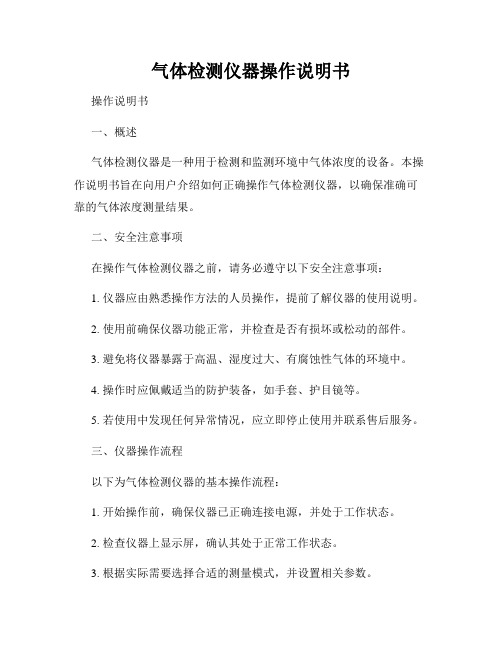
气体检测仪器操作说明书操作说明书一、概述气体检测仪器是一种用于检测和监测环境中气体浓度的设备。
本操作说明书旨在向用户介绍如何正确操作气体检测仪器,以确保准确可靠的气体浓度测量结果。
二、安全注意事项在操作气体检测仪器之前,请务必遵守以下安全注意事项:1. 仪器应由熟悉操作方法的人员操作,提前了解仪器的使用说明。
2. 使用前确保仪器功能正常,并检查是否有损坏或松动的部件。
3. 避免将仪器暴露于高温、湿度过大、有腐蚀性气体的环境中。
4. 操作时应佩戴适当的防护装备,如手套、护目镜等。
5. 若使用中发现任何异常情况,应立即停止使用并联系售后服务。
三、仪器操作流程以下为气体检测仪器的基本操作流程:1. 开始操作前,确保仪器已正确连接电源,并处于工作状态。
2. 检查仪器上显示屏,确认其处于正常工作状态。
3. 根据实际需要选择合适的测量模式,并设置相关参数。
4. 打开待测区域的气阀,允许气体进入仪器。
5. 等待一段时间,直至仪器完成测量过程,并显示出测量结果。
6. 对测量结果进行分析和评估,判断是否达到预定标准或偏离正常范围。
7. 根据实际需要记录测量结果,并进行后续处理。
四、常见故障处理1. 仪器无法开机或无法正常显示- 检查电源连接是否松动或损坏,重新连接或更换电源。
- 如电源正常,可能是仪器内部故障,需联系售后服务。
2. 仪器无法测量气体浓度- 检查传感器是否干净,若有污垢需清洁。
- 检查传感器是否损坏,如有需要更换传感器。
3. 仪器测量结果异常或不稳定- 检查环境是否存在干扰物质,如有需要采取相应措施消除干扰。
- 检查仪器校准是否正确,如需校准,按照校准流程进行操作。
五、养护与维护1. 定期清洁仪器外壳和传感器,避免灰尘和污垢的积聚。
2. 避免将仪器暴露在湿度过大或有腐蚀性气体的环境中,以免损坏仪器。
3. 如长时间不使用仪器,请将其存放在干燥通风的环境中,避免长时间不使用导致零件老化。
六、技术支持与售后服务如在仪器使用过程中遇到任何问题,可随时联系我们的技术支持与售后服务团队。
燃气检测仪器操作说明书
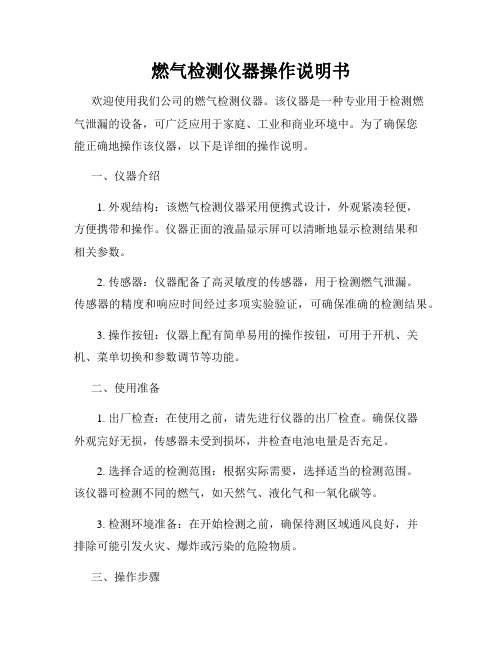
燃气检测仪器操作说明书欢迎使用我们公司的燃气检测仪器。
该仪器是一种专业用于检测燃气泄漏的设备,可广泛应用于家庭、工业和商业环境中。
为了确保您能正确地操作该仪器,以下是详细的操作说明。
一、仪器介绍1. 外观结构:该燃气检测仪器采用便携式设计,外观紧凑轻便,方便携带和操作。
仪器正面的液晶显示屏可以清晰地显示检测结果和相关参数。
2. 传感器:仪器配备了高灵敏度的传感器,用于检测燃气泄漏。
传感器的精度和响应时间经过多项实验验证,可确保准确的检测结果。
3. 操作按钮:仪器上配有简单易用的操作按钮,可用于开机、关机、菜单切换和参数调节等功能。
二、使用准备1. 出厂检查:在使用之前,请先进行仪器的出厂检查。
确保仪器外观完好无损,传感器未受到损坏,并检查电池电量是否充足。
2. 选择合适的检测范围:根据实际需要,选择适当的检测范围。
该仪器可检测不同的燃气,如天然气、液化气和一氧化碳等。
3. 检测环境准备:在开始检测之前,确保待测区域通风良好,并排除可能引发火灾、爆炸或污染的危险物质。
三、操作步骤1. 打开仪器:按下电源按钮,仪器将开始初始化,并显示相关的欢迎信息。
稍等片刻,仪器将进入待机状态。
2. 校准仪器:在开始正式检测之前,需要对仪器进行校准。
具体的校准步骤请参考仪器附带的校准指南。
3. 检测燃气:将仪器移动到待测区域,并按下检测按钮。
仪器将开始检测周围的燃气浓度。
请保持仪器与待测区域的接触,直到仪器显示出稳定的结果。
4. 读取结果:仪器将在液晶显示屏上显示出当前检测到的燃气浓度。
同时,还会提供可选的声音或震动提示功能,以便在检测不到的情况下也能收到警告。
5. 停止检测:在完成检测后,按下停止按钮以关闭仪器。
请注意,仪器在一段时间内没有动作后将自动关闭以节省电量。
四、安全事项1. 使用合适的保护装备:在进行燃气检测时,请佩戴适当的个人保护装备,如防护眼镜和手套等。
2. 避免火源:在检测到燃气泄漏时,请务必远离任何可能引发火灾或爆炸的火源。
气体检测仪的操作指南说明书
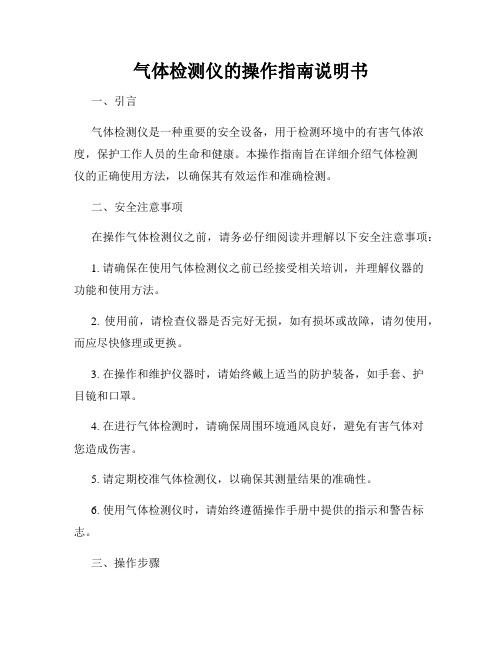
气体检测仪的操作指南说明书一、引言气体检测仪是一种重要的安全设备,用于检测环境中的有害气体浓度,保护工作人员的生命和健康。
本操作指南旨在详细介绍气体检测仪的正确使用方法,以确保其有效运作和准确检测。
二、安全注意事项在操作气体检测仪之前,请务必仔细阅读并理解以下安全注意事项:1. 请确保在使用气体检测仪之前已经接受相关培训,并理解仪器的功能和使用方法。
2. 使用前,请检查仪器是否完好无损,如有损坏或故障,请勿使用,而应尽快修理或更换。
3. 在操作和维护仪器时,请始终戴上适当的防护装备,如手套、护目镜和口罩。
4. 在进行气体检测时,请确保周围环境通风良好,避免有害气体对您造成伤害。
5. 请定期校准气体检测仪,以确保其测量结果的准确性。
6. 使用气体检测仪时,请始终遵循操作手册中提供的指示和警告标志。
三、操作步骤以下是使用气体检测仪的一般操作步骤:1. 准备工作a. 确保气体检测仪已经充电或装入新的电池,并确保电池电量充足。
b. 检查传感器是否清洁无尘,并注意是否存在损坏或老化的状况。
c. 打开仪器,等待其启动并进行自检。
2. 设置参数a. 根据需要选择适当的气体检测模式,比如单一气体检测或多气体检测。
b. 根据环境和气体类型,设置合适的报警阈值。
c. 如需进行进一步的设置,按照仪器操作手册进行操作。
3. 进行检测a. 如果需要,将气体检测仪放置在所需位置,并确保其与被测气体接触。
b. 如果需要进行移动式检测,请保持仪器稳定并避免碰撞。
c. 等待一段时间,直到仪器稳定并显示测量结果。
4. 结果分析a. 根据仪器显示的结果,判断气体浓度是否超过设定的报警阈值。
b. 如有报警,请立即采取相应的安全措施,如迅速撤离,戴上适当的防护装备等。
c. 如测量结果异常,请检查仪器状态和环境条件,并进行必要的修理或调整。
5. 记录和报告a. 如有需要,记录测量结果、时间和地点等信息。
b. 按照相关规定提交测量报告,并妥善保存相关记录。
Testo 316-2气体泄漏检测仪 使用说明书
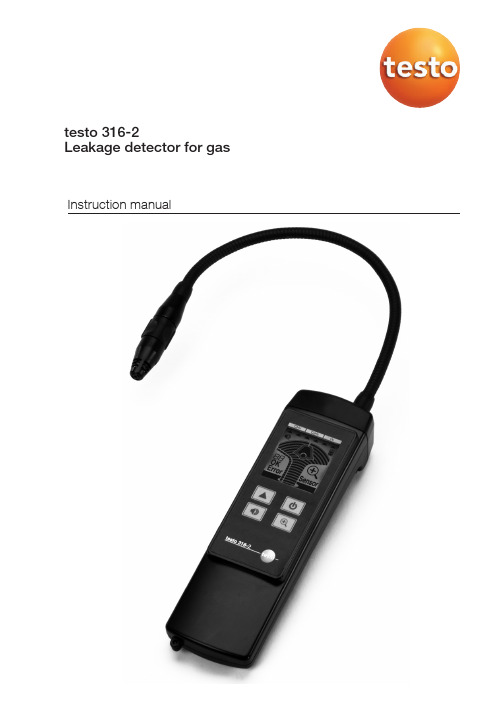
Instruction manualtesto 316-2Leakage detector for gasSafety and environment2Safety and environmentOn this document> Read this document through carefully, and familiarize yourself with the product before you put it to use. Keep this documentation close to hand in order to be able toconsult it if required. Pass this documentation on to later users of the product.> Pay particular attention to information which is marked with the following symbols:· W ith the signal word Warning!:Warns of dangers which can lead to serious injury if the prescribed safety measuresare not taken.· W ith the signal word Attention!:Warns of dangers which can lead to light injuries or material damage if the prescribedsafety measures are not taken.· Important informationAvoiding personal injury/material damage> U se the measuring instrument only for the purpose for which it is intended, and within the parameters stated in the technical data. Do not use force.> I f damage, malfunction or incorrect display occur, have the instument checked. Do not use faulty instruments.> Do not carry out measurements with the product on or near live parts.> N ever store the product together with solvents, acids or other corrosive substances. > C arry out only repair and maintenance work described in the instruction manual.Observe the prescribed handling steps. Use only original spare parts from Testo. Protecting the environment> D ispose of faulty rechargeable batteries/empty batteries at the proper collection points.> S end the product back to Testo at the end of its life. We will ensure that it is disposed of in an environmentally friendly manner.Specifications3 SpecificationsFunctions and applicationThe testo 316-2 is a gas leak detector for the fast and reliable detection of leakages on gas pipes.monitoring instrument for your personal safetyThe sensor head cannot be removed!Do not use on live parts!Do not use the instruments in environments with over 80 %RH (condensive).O bserve permitted storage and transport temperature as well as the permittedoperating temperature (e. g. protect measuring instrument from direct sunlight)!D o not use testo 316-2 in closed rooms in which gases have collected into anexplosive mixture.E nsure that the gas concentration does not exceed 20 % LFL (Lowerflammability limit).Always carry out a functionality test before gas detection.S etting the sensitivity of the sensor in gas-contaminated surroundings lowersthe alarm thresholds.T he warranty becomes void if the instrument is not used as intended or if forceis applied!Do not allow the sensor to come into contact with moisture or acids, as it willreact cross-sensitively.Specifications4Technical dataTechnical measuring dataSensor: Gas-sensitive semi-conductor· Reaction threshold: 10 ppm bei C3H8, CH4 und H2 · Reactions time: <2s· Alarm thresholdsFurther instrument dataOperating conditions: -5 to 50°C / 23 to 122°F / 20 to 80%RH, with limited functionality (only audible indi-cation, reduced accuracy, reduced operating time) can also be used in the range -20°C to -5°C / -4 to 23°F· Storage/transp. conditions: -25...60°C / -13...140°F/ 20...80%rF· Minimum bend radius gooseneck: 40 mm· Current supply: Rech. battery pack NiMh · Battery life: appprox. 6h (at 22°C / 72°F)· Charging time: approx. 8h· Dimensions: 57 x 190 x 42mm· Weight: 348gGuidelines, norms and tests· Instrument complies with worksheet DVGW G465-4Sensor dataM eas. parameter Measuring range Bar display Reaction time CH4 10 ppm to 4.0 Vol. % 1 - 18 bars < 2 sec. with pumpC3H8 10 ppm to 1.9 Vol. % 1 - 18 bars < 2 sec. with pumpH2 10 ppm to 4.0 Vol. % 1 - 18 bars < 2 sec. with pumpAlarm thresholdsM eas. parameter 1. Alarm threshold 1. Alarm 2. Alarm threshold 2. Alarm(12 bars) Accuracy (17 bars) AccuracyCH4 200 ppm ±2 bars 10.000 ppm ±2 bars C3H8 100 ppm ±2 bars 5.000 ppm ±2 bars H2 200 ppm ±2 bars 10.000 ppm ±2 barsProduct description5 Product descriptionAt a glanceÀS ensor head with gas sensor.ÁF lexible probe shaft.ÂT op: earplug socket, mains unit socket.ÃD isplay.Ä Operating buttons.Display and operating elementsDisplay MeaningColour of the display illuminationgreen No gas detected.red Gas detected.SymbolsG as concentration trend display: No gas detected / Gas detected.G as concentration trend display: First alarm threshold / Second alarm threshold.G as concentration maximum value display : Maximum gas concentration detectedsince the last reset of the maximum display or since the last time the instrumentwas switched on.Type of gas to be detected.Suppress background concentrationBattery capacity: Battery full / battery partly discharged / remaining capacity < 15min.Audible signal: on / off.Buttons FunctionInstrument: on / off.Type of gas to be detected: Select.Audible signal: on / off.+Trend display is resetone-off suppression of the background concentration (1. alarm threshold only),cancel suppression6First stepsAudible notificationThe audible notification takes place with a signal tone whose interval frequency increases with increasing gas concentrations. A continuous signal sounds when the second alarm threshold is passed.First stepsã Charging battery:Use only the original mains unit 0554 1093!The rechargeable battery can only be charged at an ambient temperatureof 0 to 45°C ( 32 to 113°F).If the rechargeable battery is completely discharged, charging takes approx. 8h.In order to ensure as long a battery life as possible, the battery shoud always becompletely discharged and recharged.The instrument can continue to be used during charging.1Plug the mains plug into the country-specific adapter and then plug into the mains socket.2Plug the instrument plug into the mains unit socket of the instrument.- Charging begins: , and light up alternately.- Charging stops automatically when the rechargeable battery is full: lights up.ã Using the earplug:Use only the original earplug 0554 5001!The instrument loudspeaker is deactivated when the earplug is plugged in!> Plug the connection plug of the earplug into the earplug socket of the instrument.Using the product7 Using the productã Switching on the instrument:1 Press .- All display segments light up (duration: 3 sec), the suction pump starts (ventilator noise).- The initialization phase is carried out (heating, auto-test). The remaining duration is displayed.- After the end of the initialization phase: OK lights up (duration: 2 sec).Attention! Danger of burning from the hot sensor head after prolonged use!>B efore touching the sensor head or packing up the instrument, switch offand allow to cool.ã Selecting gas to be detected:> Press several times, until the arrow lights up under the desired gas type.ãSuppress background concentration> Press .- lights up. The background concentration is suppressed.> Press again.- goes out. Background suppression is removed. The current gas concentration is displayed.Using the product8ã Carrying out gas detection:Attention! Destruction of the sensor by non-desorbant substances (e.g. oils)!>Do not use the instrument in dirty surroundings.> Move the sensor head as close as possible, and slowly (3 to 5 cm per second) over the parts which are to be examined for leaks.ã Resetting maximum value display:> Press and simultaneously.ã Switching instrument off:> Press and hold until the display switches off.Maintaining the product9 Maintaining the productâ Charging the rechargeable battery:See chapter “First steps”â Cleaning the sensor:Tobacco smoke, dirty air, oils, grease, silicones and evaporating liquids or gases can lead to deposits on the surface of the sensor. This can result in reduced sensitivity and falsified display of concentrations. If necessary clean the sensor.> Switch on the instrument, wait until the end of the initialization phase and switch off again. Repeat this procedure several times.â Clean the sensor head from the outside> If dirty, clean the sensor head with a soft dry cloth.â Cleaning the housing:> If dirty, clean the housing with a damp cloth (soap solution). Do not use aggressive cleaning products or solvents!â Switching on regularlyIf the instrument is used infrequently, deposits may build up on the sensor.Switching the instrument on prevents deposits building up on the sensor. Testorecommends switching the instrument on regularly to avoid deposits building upon the sensor.â Storage & transportationTo avoid contamination of the sensor, the instrument should not be storedor transported in an environment where there is tobacco smoke, foul air, oils,greases, silicones or evaporating liquids or gases. Any sensor that is contaminated as a result of storage or transportation must be cleaned before use, see Cleaning the sensor.â Regular servicing:Testo recommends yearly servicing of the gas detector by an authorized servicecentre.Tips and assistance10Tips and assistanceQuestions and answersQuestion Possible causes / solutions“Error 01” · I nstrument error: please contact your dealer or Testo customer service.“Error 02” · S ensor defective (wire breakage): please contact your dealer or Testo customerservice.“Error 03” · S ensor connection faulty: Steckverbidnung des Sensorkopfes prüfen Pleasecontact your dealer or Testo customer service“Sensor” blinkt · S ensor dirty: clean sensor, see chapter “Maintaining product”.If we were not able to answer your question, please contact your dealer or Testocustomer service. For contact data, see back of this document or web page www.testo.com/service-contact.Accessories and spare partsDescription Part no.Earplug 0554 5001 Mains unit 0554 1093 testo 316-2 0632 316211 e d n e。
气密检漏仪的操作说明

气密检漏仪的操作说明气密检漏仪是一种精密的检测设备,广泛应用于各行业的产品质量检测中。
下面将就气密检漏仪的操作进行详细说明,以便用户能够正确地使用气密检漏仪进行检测。
1. 气密检漏仪的组成气密检漏仪由下面的几部分组成:•主机:气密检测主机,包括仪器的显示屏、操作按钮、控制软件等部分;•探头:用于检测被测试物体的探头,包括探头连接线等部分;•气源:用于提供测试气体的气源设备;•软件:用于分析测试数据和生成检测报告的软件。
2. 气密检漏仪的操作2.1 准备工作在使用气密检漏仪进行检测之前,需要进行一些准备工作:•选择正确的探头:根据被测试物体的特点,选择相应的探头进行测量;•连接气源:根据仪器说明书,将气源连接到气密检漏仪上;•开机:将气密检漏仪插入电源并将仪器开机。
2.2 操作步骤1.打开软件:在电脑上打开气密检测软件,根据指示向后台传输相应的信息进行连接。
2.设置参数:设置好检测参数,例如测试压力、测试时间和测试方法等。
3.连接探头:将选择好的探头连接到检测被测试物体上,并将仪器与探头连接。
4.开始测试:按下仪器上的“开始测试”按钮即可进行检测;5.结果分析:等待测试结果出来后,应该好好分析测试结果,并提取一些有用的判断信息;6.停止测试:测试完成后,及时停止检测,关闭气源。
2.3 注意事项在操作气密检漏仪时,需要注意以下几个方面:•仪器的操作要准确:在使用气密检漏仪时,需要按照正确的方法和步骤进行操作,否则会影响测试结果的准确性;•控制测试压力:在进行检测时,需要控制测试压力,以免造成对被检测物件的损坏和误测;•测试时间不能过长:测试时间过长会浪费时间,同时也可能会对被检测物体造成损坏;•保持探头的清洁和完好:检测探头需要保持清洁,并且不能在不当的情况下进行钩挂或者弯曲,否则会影响测试数据的正确性。
3. 总结使用气密检漏仪进行检测时,需要遵循正确的操作步骤,同时需要注意保养和维护。
通过对气密检漏仪的操作说明,相信读者已经对气密检漏仪有了更深入的了解,并能够准确地使用气密检测仪进行测量,从而保证了被测试物件的质量和安全。
testo 316-1-EX 气体泄漏检测仪使用说明书

testo 316-1-EX gas leak detector 0560 3163Instruction manualContents Contents1About this document (3)2Safety and disposal (3)2.1Security (3)2.2Disposal (4)3Product-specific information (5)4Intended use (5)4.1Special conditions for the usage (6)5Product description (7)5.1Instrument overview (7)6First steps (8)6.1Getting to know the product (8)6.1.1Switching the instrument on and off (8)6.2Establishing a Bluetooth® connection (9)6.2.1Establishing a Bluetooth® connection to the testo Smart App (9)7Using the product (10)7.1Controls (10)7.1.1Implementing settings (12)7.2Carrying out a function test (15)7.3Carrying out gas detection (15)8Maintaining the product (19)8.1Charging the rechargeable battery (19)8.2Cleaning the instrument (19)8.3Cleaning the sensor (19)9Technical data for testo 316-1-EX (21)10Tips and assistance (22)10.1Questions and answers (22)10.2Error codes (22)10.2.1Hard Reset (22)10.3Accessories and spare parts (22)11Support (22)1 About this document1 About this document•The instruction manual is an integral part of the instrument.•Please keep this documentation available for future reference.•Always use the complete original instruction manual.•Please read this instruction manual through carefully and familiarize yourself with the product before putting it to use.•Hand this instruction manual on to any subsequent users of the product. •Pay particular attention to the safety instructions and warning advice in order to prevent injury and damage to the product.2 Safety and disposal2.1 SecurityGeneral safety instructions•Only operate the product properly, for its intended purpose, and within the parameters specified in the technical data.•Do not apply any force.•Do not operate the instrument if there are signs of damage on the housing, mains unit or connected cables.•Dangers may also arise from objects to be measured or the measuring environment. Always comply with the locally valid safety regulations when carrying out measurements.•Do not store the product together with solvents.•Do not use any desiccants.•Only perform maintenance and repair work on this instrument that is described in this documentation. Follow the prescribed steps exactly when doing the work.•Use only original spare parts from Testo.•Only use the original mains unit from Testo.•The substantial safety and health requirements are fulfilled in accordance with the following norms:o EN IEC 60079-0:2018o EN 60079-11:2012•The gas leak detector must not be exposed to the processes that generate significant electrostatic charges.32 Safety and disposal4Batteries• Improper use of batteries may cause the batteries to be destroyed, or lead to injury due to current surges, fire or escaping chemicals.• Do not expose the batteries to heavy impacts, water, fire or temperatures in excess of 60 °C.• In the event of contact with battery acid: rinse affected areas thoroughly with water, and if necessary consult a doctor.• Only charge the battery using the original Testo mains unit supplied.• Immediately stop the charging process if this is not completed in the given time.WarningsAlways pay attention to any information denoted by the following warnings. Implement the precautionary measures specified!DANGER Risk of death!WARNINGIndicates possible serious injury.CAUTIONIndicates possible minor injury.Indicates possible damage to equipment.2.2 Disposal• Dispose of faulty rechargeable batteries and spent batteries in accordance with the valid legal specifications.• At the end of its useful life, deliver the product to the separate collection point for electric and electronic devices (observe local regulations) or return the product to Testo for disposal.•WEEE Reg. No. DE 753343523 Product-specific information 3 Product-specific information•Do not carry out measurements on live components.•Do not operate the instrument in environments above 80 %RH (condensing). •Observe the permissible storage and transport temperatures and the permissible operating temperature (e.g. protect the measuring instrument from direct sunlight)!•Always carry out a function test before searching for gas leaks.•If the instrument is misused or subjected to force, all warranty claims will be voided!•Do not allow the sensor to come into contact with moisture or acids, as it will react cross-sensitively.4 Intended useThe testo 316-1-EX is a gas leak detector for the short-term detection of leaks in gas systems in potentially explosive atmospheres of the classATEX II 2 G Ex ib IIC T1Gb according to Directive 2014/34/EU (ATEX).The following substances can be detected:•Methane CH4•Propane C3H8•Butane C4H10•Hydrogen H2The instrument is not suitable for precise measurement of the gas concentration.A flammable substance in the air has a lower explosive limit (LEL) and an upper explosive limit (UEL).The air/gas mixture is flammable anywhere between these two limits, potentially leading to an explosion (critical range).Below the LEL, the mixture is too lean for an explosion, and above the UEL it is too rich (non-critical range).The explosive limits depend on the substance:-Methane CH4: LEL 4.4 vol.% / UEL 16.5 vol.%-Propane C3H8: LEL 1.7 vol.% / UEL 10.9 vol.%-Butane C4H10: LEL 1.4 vol.% / UEL 9.4 vol.%-Hydrogen H2: LEL 4.0 vol.% / UEL 77.0 vol.%54 Intended use 6- Do not use the instrument as a monitoring instrument for personal safety! The instrument is not protective equipment!- Do not use the instrument as a gas analyzer! The sensor detects almost all combustible gases alike.4.1 Special conditions for the usage • The gas leak detector must only be used in potentially explosive atmospheres of the IIC T1 class.• The gas leak detector must only be used in the ambient temperature range from -5 °C to +50 °C.• The gas leak detector must not be exposed to the processes that generate significant electrostatic charges.• The gas leak detector must only be recharged using the corresponding charger outside of a potentially explosive atmosphere in the ambient temperature range from 0 °C…+45 °C.• The charging voltage must not be higher than U m = 8.5 V.This voltage can be provided using one of the following measures in accordance with IEC 60079-14:o making sure that U m in a SELV/PELV system can not be higher than50 V AC or 120 V DC;o using a safety transformer that fulfils all requirements according toIEC 61558-2-6 or an equivalent technical standard;o connecting it directly to an instrument that fulfils all requirementsaccording to IEC 60950 and its successors, IEC 61010-1 or anequivalent technical standard; ousing a direct power supply source, e.g cells or batteries.• The expected short-circuit current during the charging process must not exceed 50 A.Use only the supplied mains unit to fulfil all charging requirements.5 Product description5 Product description5.1 Instrument overviewSymbol explanation76 First steps86 First steps6.1 Getting to know the product6.1.1 Switching the instrument on and off Switching onOnly switch on the instrument in fresh air, since automatic zeroing is carried out when the instrument is switched on. The ambient temperature and ambient humidity during zeroing should correspond to the ambient conditions at themeasuring location. If necessary, zero again manually at the measuring location (switch off and on again).If the unit is not used for a prolonged period of time, the sensor willbecome contaminated. Particularly if the instrument has not been in operation for a prolonged period of time (> 2 weeks), it should be left switched on for a while before being used. The longer it has not been in operation, the longer this additional warming-up phase should be.Please note that the instrument switches itself off by default after 10 min of inactivity.1 Press and hold down (1 sec) the On/Off key.Warm-up phase (HEAT)↓ The instrument starts up. With regular use, the warm-up period takes approx. 30 sec and is symbolized by the text “HEAT” and acountdown.As long as the sensor LED is flashing orange, the instrument is not ready for use.↓ Following the warm-up period, the measurement view is displayed.Self-cleaning (CLN)↓ If the sensor is dirty, the warm-up phase is followed by the sensor cleaning phase. This usually happens when the instrument has notbeen used for several days. The self-cleaning is symbolized by the text “CLN” and a countdown.Switching offCAUTION Caution! Risk of burns due to hot sensor head after prolongedoperation.- Before touching the sensor head or packing the instrument: switchinstrument off and let the sensor head cool down.6 First steps91 Press and hold down (1 sec) the On/Off key.↓ The instrument is switched off.Auto OFFAfter 10 minutes of inactivity (no user input, no gas concentration above the warning threshold), the instrument switches itself off. The switch-off is signalled beforehand by an alarm sound, red flashing of the sensor LED and a 10 sec countdown.You can prevent the instrument from switching off by pressing any key within 10 seconds.Enabling/disabling the Auto-OFF function:1 Press the Sound and UNIT keys simultaneously for 1 sec.↓ Enabling/disabling is confirmed by "AOFF ON" or "AOFF OFF".6.2 Establishing a Bluetooth ® connectionThe instrument can be connected to the testo Smart App viaBluetooth ® connection.✓ The gas leak detector is switched on.6.2.1Establishing a Bluetooth ® connection to the testo Smart AppTo establish a connection via Bluetooth ®, you need atablet or smartphone with the Testo Smart App alreadyinstalled on it.You can get the App for iOS instruments in the App Storeor for Android instruments in the Play Store.Compatibility:Requires iOS 13.0 or later/Android 8.0 or later,requires Bluetooth ® 4.2.1 Open the testo Smart App.↓ The app automatically searches for Bluetooth ® devices in the vicinity.2 In the Bluetooth menu, check whether the required instrument is connected.7 Using the product10 ↓ If necessary, switch the instrument to be connected off and on again to restart the connection mode.7 Using the productFor technical reasons, the accuracy of the sensor improves with longer operating time of the sensor.For accurate measurements in ppm or calibrations, the device must be switched on for at least 10 minutes (after the warm-up phase).Please note that the instrument switches itself off by default after 10 min of inactivity. You can avoid this by disabling the Auto-off function (see chapter 6.2.1).Lighters are only suitable to a limited extent for a function test due to the different liquid gas mixtures used in commercial lighters and the selectivity of the sensor based on the gas set (GAS button).The gas leak detector can be used in conjunction with the testo Smart App .7.1 Controls✓ The instrument is switched on.✓ The app is installed on the smartphone and connected to theinstrument via Bluetooth ®.↓ Settings and controls are primarily carried out on the instrument and are transferred to the app. To a lesser extent, control via app is also possible (selection of gas type).7 Using the product1 Sound / Illumination key2 On/Off / GAS key3 Bar display4 Mode5 Measurement parameter6 Display for alarm signal, Bluetooth®, charge level7 Maximum measured value8 Current measured value7 Using the productThe Main menu can be accessed via the icon at top left. To exit the main menu, select a menu or right-click on the guided menus. The last screen displayed is shown.7.1.1 Implementing settingsSelecting, opening and setting functions1 Press the relevant key to select the functions.Secondary assignment (long press)All keys with a white corner have a secondary assignment, which can be selected by pressing and holding the key (1 sec).Adjustable functionsEnsure correct settings: all settings are transferred immediately. There is no Cancel function.7 Using the product Measurement parameterDisplay illumination / sensor LED(long press)Alarm soundUnit (long press)7Using the product Max. zeroing (long press) Zeroing7 Using the product7.2 Carrying out a function test1 Apply low-concentration gas to the sensor (max. 10 sec).↓If the sensor does not respond (no alarm), the instrument is defective and must no longer be used. The instrument must be taken to theservice centre for repair.Due to the selectivity of the sensor, gas equivalents are not suitable forchecking the function and especially not for calibrating the sensor.7.3 Carrying out gas detectionHave the instrument serviced annually by the manufacturer.Testing natural gas lines or hydrogen lines:Methane (main component of natural gas) or hydrogen are lighter thanair, detection should be carried out above the pipe / suspected leak.Testing propane and butane gas lines: Propane and butane are heavierthan air, detection should be carried out below the pipe / suspectedleak, starting from the bottom and working upwards.Selecting the gas to be detected1 Select the gas types via the GAS key or the testo Smart App using the3-point menu in the top right corner of the output field↓After switching on the instrument, the process of cycling through starts with methane (CH4).Automatic identification of common gas typesThe gas is automatically detected and indicated by a flashing gas icon on the display if a gas concentration currently applied to the sensor has characteristics of a different gas type than is currently selected.For technical reasons, this is subject to uncertainty and is intended as a support for users, and must therefore always be checked by the user.7Using the productSelecting the mode1 Press the MODE key to switch between modes.MODE 1 is suitable for measuring the general gas concentration in indoor areas.↓The gas concentration is indicated bythe increasing bar display.MODE 2 is suitable for locating a leak. In this mode, rising or falling concentration values are output.↓At the beginning, two bar segmentsare displayed in the middle.At the same time, the sensor LEDflashes in a colour corresponding tothe concentration value and an audiosignal is emitted at the samefrequency.↓As the concentration increases, adeflection to the right is displayed.The frequency of the flashing/audiosignal increases.As the concentration decreases, adeflection to the left is displayed. Thefrequency of the flashing/audio signaldecreases.7 Using the product↓If the concentration remains unchanged, the deflection moves back to the centre. The deflection is reset manually using the [--> 0 <--] key Carrying out the measurement1 Move the sensor head as close as possible and at low speed (approx.< 2 cm per second) over the components that are to be checked forleaks.The surface of the sensor must not be covered.↓•Concentration < 100 ppm: The sensor LED and the displayillumination light up green. In addition, the bar display increases.•Concentration > 100 and < 999 ppm: The sensor LED and the display illumination light up yellow. In addition, the bar displayincreases.•Concentration > 999 ppm: The unit changes to VOL% and the bar display increases.•Concentration > 9999 ppm / > 0.99 VOL%: The sensor LED and the display light up red (alarm threshold).↓When the lower explosive limit is reached, ">LEL" is displayed. Higher values are not displayed.To locate the leak, it is advisable, in the case of these larger leaks, toswitch to MODE 2 in order to receive feedback via audio and flashingsignals.↓If the warning threshold (100 ppm) is exceeded, the sensor LED and display illumination light up yellow. If the acoustic alarm is enabled, anadditional warning sound is emitted when the warning threshold isexceeded, the frequency of which increases as the concentrationincreases, and changes to a continuous tone when the second alarmthreshold (10,000 ppm) is exceeded.Changing unitsBy default, the display shows ppm (concentration in parts per million). From a concentration of >999 ppm, the display changes to vol% (1000 ppm=0.1 vol%). Higher concentrations in ppm are also displayed in the app.In addition, %LEL (the percentage of the lower explosive limit that has been reached) can be selected.1 Press the unit key to change the unit.Carrying out manual zeroingThe zero point can only be set manually if the currently detected gas concentration is below the max. 250 ppm (max. 250 ppm can be suppressed). For example:•150 ppm (≤ 250 ppm): are completely suppressed (display: 0 ppm)7Using the product•1000 ppm (> 250 ppm): 250 ppm are suppressed (display: 750 ppm)Gas concentrations present at the time of zeroing are suppressed byzeroing. As a result, the displayed reading no longer corresponds to thereal gas concentration.✓ The instrument is in measurement view.1 Briefly press [--> 0 <--].↓The zero point for the current reading is reset or the currentsuppression is cancelled.↓On instruments with a display, the suppression of the reading is symbolized by an arrow pointing downwards on the display.The maximum reading can be zeroed using [max --> 0 <--].After the measurement1 Ventilate the sensor thoroughly after each use. To do this, place theinstrument in fresh air for approx. 2 minutes before using it again.8 Maintaining the product8 Maintaining the product8.1 Charging the rechargeable batteryDANGER- Do not charge the rechargeable battery in potentially explosive atmospheres!Only charge the battery using the original Testo mains unit supplied. The instrument indicates that the battery needs to be charged via a flashing battery symbol.1 Connect the instrument to the mains via the mains unit. To do this,insert the plug of the mains unit into the charging socket on theunderside of the instrument.When the mains unit is plugged in during operation, the instrumentswitches off due to ATEX regulations.The instrument can become very warm during charging and should notbe held in your hand.8.2 Cleaning the instrument1 If the housing of the instrument is dirty, clean it with a damp cloth.Do not use any aggressive cleaning agents or solvents! Mild householdcleaning agents and soap suds may be used.Storage & transportationTo prevent contamination of the sensor, please do not store or transport the instrument in an environment where any tobacco smoke, foul air, oils, greases, silicones, evaporating liquids or gases are present. Any sensor that is contaminated as a result of storage or transportation must be cleaned before use, see Cleaning the sensor.Regular inspectionTesto recommends having the gas leak detector inspected by an authorized service centre every year.8.3 Cleaning the sensorTobacco smoke, dirty air, oils, greases, silicones and evaporating liquids or gases can leave deposits on the sensor surface. Possible consequences are8Maintaining the productreduced sensitivity, distorted displays of gas concentration or display of a background concentration. Clean the sensor if necessary1 Switch on the instrument, allow it to initialize and then switch it off.Repeat this procedure several times.2 If it is dirty, clean the sensor head with a soft, dry cloth.Switching on regularlyIf the instrument is used infrequently, deposits may build up on the sensor. Switching the instrument on prevents these deposits from building up on the sensor. Testo recommends switching the instrument on regularly to avoid deposits building up on the sensor.Changing the sensor headThe instrument has a permanently installed sensor head that can only be replaced by Testo Customer Service.9 Technical data for testo 316-1-EX 9 Technical data for testo 316-1-EX2110Tips and assistance10 Tips and assistance10.1 Questions and answers10.2 Error codesThe error code is shown on the display.10.2.1 Hard Reset1 If you encounter any problems with the firmware, press and hold theON/OFF key for a long time (4 sec.) to perform a reset.10.3 Accessories and spare parts11 SupportYou can find up-to-date information on products, downloads and links to contact addresses for support queries on the Testo website at: .If you have any questions please contact your local dealer or the Testo Customer Service. You can find contact details on the back of this document or online at /service-contact.22Testo SE & Co. KGaACelsiusstraße 279822 Titisee-NeustadtGermanyTelefon: +49 7653 681-0E-Mail:*************Internet: 0970 3263 en 05 - 04.2023。
空气测漏仪操作手册
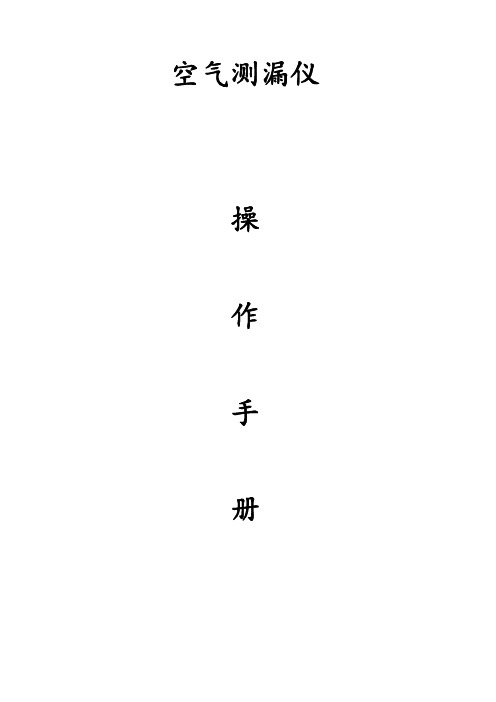
a.将被测件接入仪器[被测件]端。 b.按[检测]键
仪器自动控制充气、平衡、检测,显示压降值,判定合格(红灯亮)
12
/不合格(绿灯亮)。
操作手册
c.测试结束,取下工件
8.使用注意事项
a. 每天使用该仪器前,必须预热 5~10 分钟,再复位进入系统。
0 点校准:
如果开机后,在未接工件的情况下,检压力(或压降)不为 0(或 0 点附近)
次使用仪器前进行检测,验证仪器是否能准确判别合格与否。
b. 如生产节拍允许,可加长平衡时间;如生产节拍较快,在保证检测精度要求的
情况下,可减少平衡时间。
c. 检测过程中被检测件不能有大的抖动。
d. 试件允许有小泄漏的地方,必须封密堵塞。如发动机进、排气门;油尺。
e. 仪器重复性性能检测:当需要对同一试件进行重复检测气密性时,检测件必须
充分放气,放气时间视试件容积大小而定。
13
9.记录删除
操作手册
在检测界面,长按[0]键,进入统计结果清零提示,按[Ent]键清零统计结果退出。按
其它键退出不清零。
每次的累计数据会隔 10 分钟储存一次,如果在断电或关机时想要把检测总计数储存
于数据库中,必须按一下“Ent”键,并等待 5S 后关机,使其永久性记录。
10.2.1.压力、差压调校气路连接图
说明:0.4~0.8MPa 气源接入气密检测仪的气源输入口,“数显精密压力表”
接气密检测仪的接试件口。
10.2.2 压力量程调校步骤
a. 取下检测仪的外罩,逆时针调节检测仪内部的压力调节阀,使其输出压力到最
小 0。
b. 将气密检测仪通电 5 分钟,取下与“数显精密压力表”连接的管路,按检测仪
SF6气体检漏仪说明书

SF6气体检漏仪说明书概述SFe气体检漏仪是测量气体泄漏的新一代产品,它具有灵敏度高、稳定性好、响应速度快、操作简便、移动范围大,可迅速、准确的定性和定量检测SF6断路器和GIS的泄漏点及年泄漏率。
本仪器十分适合于供电部门、安装检修单位和电力试验研究所使用,同时也十分适合SF6高压开关厂作为SF6电器设备及出口产品的配套仪器,从而提高了整体产品的档次。
二、主要技术指标1、最小检测值:1 (X 1 0 一6体积比)2、检测范围:1〜1 0 0 0 (XI 0 ~6体积比)3、响应时间:VI秒4、恢复时间:V 1 0秒5、示值误差:W± 3 %6、重复性:W1%7、传感器静止时最大灵敏度:3 g/年8、指示方式:数字显示和声光讯号9、探枪检测长度:手持式1 0、连续工作时间:5小时1 1、仪器电源:可充电镰氢电池,交直两用1 2、使用环境:温度:一5€〜+4 5 °C相对湿度:W 8 513、整机重量:2公斤1 4、体积:长X宽><高=230mmX 130mmX 45mm三、主要特点1、体积小,重量轻,便携式,手持蛇形探头,连线增加易弯性。
2、灵敏度高:超级感应,对细微的卤素气体有响应,可检每年3g以上气体泄漏量。
3、测量范围宽:仪器可在SF6开关装置的泄漏率范围内检测SFe的漏气量,可两档切换选择。
4、准确度高:仪器采用先进的校验方法校验,给出高准确度的校准线,提高了SF6检漏结果的可信度和定量检漏的精度。
5、显示直观,声光报警:采用数字液晶,带背光显示,具有简便直观的效果。
当有SF6存在时,仪器发出声光报警。
6、反应速度快,恢复时间短:采用新型电路结构,使仪器的反应速度加快,恢复时间缩短,这极大地方便了现场检测。
7、使用时间长:使用时间可达5小时,十分适合于现场,SFe 高压开关厂和研究所使用。
8、可充电电池,一次可连续使用5小时以上。
四、操作步骤1、先将手持式探头上的连接线插头接到仪器液晶显示屏下方的插座上扭紧,然后打开电源开关,“Full- charge ”灯亮,液晶屏显示“欢迎使用”,然后进入第二屏“ 1、运行2、设置”。
检漏仪使用方法说明书

检漏仪使用方法说明书注意:本文为虚构内容,仅供参考。
使用方法说明书尊敬的用户,感谢您选择我们的检漏仪。
为了确保您能正确、方便地使用该仪器,我们特别为您提供了本使用方法说明书。
请您仔细阅读以下内容,并按照说明进行操作。
1. 检漏仪概述检漏仪是一种用于检测和定位管道或容器中泄漏位置的仪器。
它采用了先进的传感技术和信号处理算法,能够在最短的时间内精准地发现泄漏点。
2. 安全注意事项在使用检漏仪之前,请务必阅读并遵守以下安全注意事项:- 在操作过程中要佩戴适当的防护装备,包括手套、眼镜等。
- 请确保您在操作时处于安全的环境,远离可燃或有害物质。
- 请勿将检漏仪用于其它非指定用途。
3. 检漏仪的使用步骤步骤一:准备- 将检漏仪放置在稳定的平面上,并连接电源。
- 根据实际需要,选择合适的传感器,并将其连接到仪器上。
步骤二:仪器设置- 按下电源开关,待仪器启动成功后进入菜单界面。
- 使用方向键选择功能选项,根据需要进行相应的设置,如音量、灵敏度等。
步骤三:泄漏检测- 将传感器放置在需要检测的管道或容器周围。
- 检漏仪会实时监测泄漏信号,当检测到异常信号时会发出警报。
步骤四:泄漏定位- 根据检漏仪显示的泄漏信号强度,移动传感器并标记信号最强的位置。
- 通过不断调整传感器位置,逐渐缩小泄漏位置的范围,以确定泄漏点。
4. 注意事项及故障排除- 如果在使用过程中发现仪器显示异常或警报频繁,请检查电源连接是否良好,是否需要更换传感器。
- 使用时请避免与其他电子设备或强电磁场接触,以免影响仪器的正常工作。
5. 保养与存储- 使用完毕后,请将传感器清洁并妥善包装。
- 将检漏仪存放在干燥、通风良好的地方,避免长时间存放在高温、潮湿环境中。
再次感谢您选择我们的检漏仪。
如有任何问题或需要进一步的帮助,请随时与我们联系。
祝您使用愉快!此为检漏仪使用方法说明书,仅为用户提供操作指导,不涉及特定品牌或型号的实际产品。
具体使用方法请根据您所购买的检漏仪的具体说明来操作。
SF6气体检漏仪使用说明

操作说明1、打开电池开关,发光二极管将显示复位指示2秒钟(左灯绿色,其它灯橙色)。
2、通过观察发光二极管核对电池电力(见上)3、开机时,本产品默认为灵敏度5级,此时可听到间隔稳定的“嘟、嗜”声,如果需要可通过灵敏度调整键改变灵敏度。
4、开始检漏时,当泄漏的气体被发现,“嘟嘟”声将变得急促,发光管也将根据浓度的变化改变发光方式。
5、灵敏感度可在操场作中的任何时候时行调整,且不影响检测。
6、如泄漏源被定位之前,已达到最高警示(发光二极管1绿6红)。
应按复位键复位到零参考水平。
操作注意事项1、当泄漏不能被测出时,才调高灵敏度。
当复位不能使仪器“复位”时,才调低灵敏度。
2、在被严重污染的区域,应及时复位仪器以消除环境对仪器的影响。
复位时不要移动探头。
本仪器可根据需要任意次复位。
3、有风的区域,即使大的泄漏也难发现。
在这种情况下,最好遮挡住潜在泄漏区域。
4、若探头接触到湿气或溶剂时可能报警,因此,检查泄漏时避免接触到它们。
推荐操作方法1、空调系统应加入足够的制冷剂,使其在不工作的情况下保持至少340Kpa(50PSI)的压力。
温度低于15℃时,泄漏可能不能测出,因为这时可能压力不足。
2、被测出部件有污染时,注意不要污染探头。
如果部件非常脏。
或存有凝固物,应用干的工业手巾擦掉或用压缩空气吹掉。
不能使用清洁剂或溶剂,因为它们会对探险头产生影响。
3、目测整个制冷系统,检查所有管道,软管,构件有无润滑油泄漏、损坏、腐蚀等痕迹的地方,每个有问题的区域都应用探头仔细检测。
4、在冷剂系统中应顺着连贯的路径检测,不要有遗漏,如果找到一漏孔,一定要继续检测所剩的部分。
检漏时,探头要围绕被检部件移动,速率要求不大于25~50毫米/秒,并且离表面距离不大于5毫米,要完整地围绕部件移动,这样才能达到最佳期检测效果,有啸叫声表示找到了漏孔。
5、此时应将仪器拿开,重新调节灵敏度到合适位置,对刚刚检测过的部件再仔细检查一遍,确定漏孔的确切位置。
气体检测仪操作方法说明书
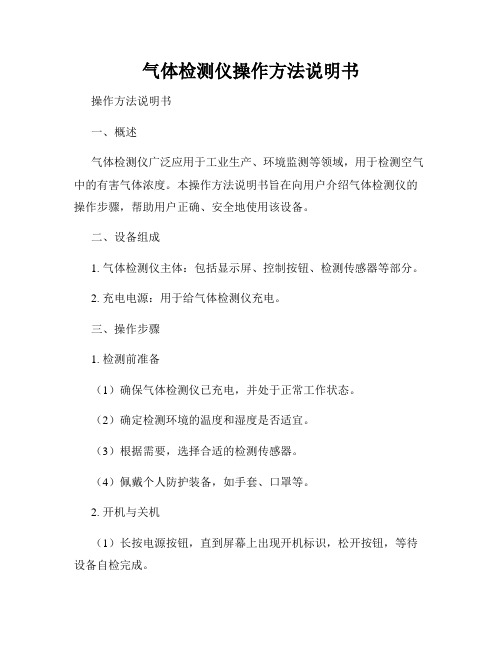
气体检测仪操作方法说明书操作方法说明书一、概述气体检测仪广泛应用于工业生产、环境监测等领域,用于检测空气中的有害气体浓度。
本操作方法说明书旨在向用户介绍气体检测仪的操作步骤,帮助用户正确、安全地使用该设备。
二、设备组成1. 气体检测仪主体:包括显示屏、控制按钮、检测传感器等部分。
2. 充电电源:用于给气体检测仪充电。
三、操作步骤1. 检测前准备(1)确保气体检测仪已充电,并处于正常工作状态。
(2)确定检测环境的温度和湿度是否适宜。
(3)根据需要,选择合适的检测传感器。
(4)佩戴个人防护装备,如手套、口罩等。
2. 开机与关机(1)长按电源按钮,直到屏幕上出现开机标识,松开按钮,等待设备自检完成。
(2)在使用完毕后,长按电源按钮,直到屏幕上出现关机标识,松开按钮,待设备关机。
3. 检测操作(1)根据需要,选择探测气体类型。
(2)将气体检测仪与待检测环境相连。
确保连接端口紧密且无漏气。
(3)观察显示屏上的数值变化,等待气体检测仪稳定后记录数据。
(4)根据设备说明书,判断检测结果是否超过安全阈值。
4. 数据记录与导出(1)按照设备说明书,将数据导出至计算机或其他存储设备。
(2)对记录的数据进行分析和整理,制作相应报告。
5. 设备维护(1)定期清洁气体检测仪,特别是传感器部分。
(2)确保充电电源的正常工作,并及时充电。
6. 注意事项(1)在操作气体检测仪过程中,遵守相关安全规定和操作规程。
(2)不允许将气体检测仪用于非法用途。
(3)在使用过程中,避免设备受到严重冲击和振动。
(4)严禁使用损坏或失效的气体检测仪。
结束语本操作方法说明书详细介绍了气体检测仪的操作步骤,希望能帮助用户正确使用该设备,并达到有效检测有害气体浓度的目的。
在操作过程中,请严格遵守使用规范,确保个人和环境的安全。
如有其他问题,请参考设备说明书或咨询相关专业人员。
祝您使用愉快!。
四合一气体检漏仪使用说明书 气体检漏仪操作规程
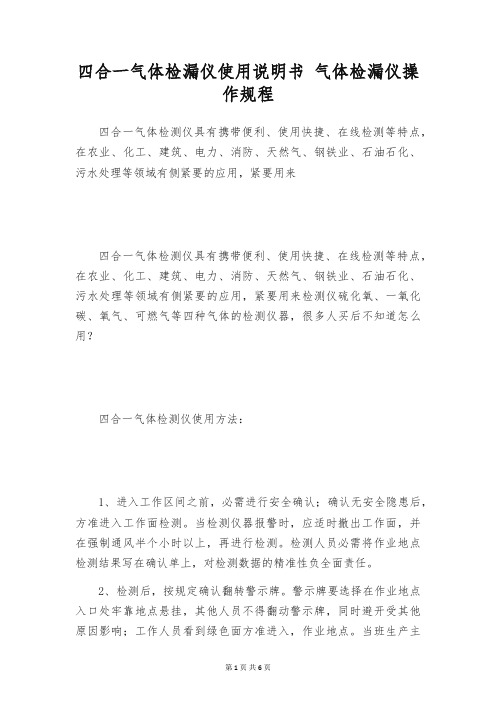
四合一气体检漏仪使用说明书气体检漏仪操作规程四合一气体检测仪具有携带便利、使用快捷、在线检测等特点,在农业、化工、建筑、电力、消防、天然气、钢铁业、石油石化、污水处理等领域有侧紧要的应用,紧要用来四合一气体检测仪具有携带便利、使用快捷、在线检测等特点,在农业、化工、建筑、电力、消防、天然气、钢铁业、石油石化、污水处理等领域有侧紧要的应用,紧要用来检测仪硫化氧、一氧化碳、氧气、可燃气等四种气体的检测仪器,很多人买后不知道怎么用?四合一气体检测仪使用方法:1、进入工作区间之前,必需进行安全确认;确认无安全隐患后,方准进入工作面检测。
当检测仪器报警时,应适时撤出工作面,并在强制通风半个小时以上,再进行检测。
检测人员必需将作业地点检测结果写在确认单上,对检测数据的精准性负全面责任。
2、检测后,按规定确认翻转警示牌。
警示牌要选择在作业地点入口处牢靠地点悬挂,其他人员不得翻动警示牌,同时避开受其他原因影响;工作人员看到绿色面方准进入,作业地点。
当班生产主管应对当班检测人员的工作进行监督检查,确保本规定的有效落实。
3、将探头置于待测环境中,当有被测气体泄漏时,浓度显示的数值变大,当超过报警设定值时,报警指示灯亮,同时发出报警声。
当探头移动到泄漏源时,四合一气体检测仪浓度显示屏显示的数值为。
4、当四合一气体检测仪电池电量低提示时,说明电池已经快没电了,应适时关闭电源,并使用充电器给电池充电,每次充电为10—14小时!5、充电方法:把电源充电器插到AC220V电源插座上,再把充电插头插到探测器的充电插口内,再把四合一气体检测仪电源开关打开,给探测器充电,绿色工作灯亮,电池灯闪亮,显示屏显示————“,充电完成后,关闭电源开关,拔出充电器6、检测人员检测时,要保持两人以上的人数,一人操作,另一人监护,前后保持确定距离,严禁单人作业。
使用四合一气体检测仪必需遵守检测要求,尽职尽责地做好气体检测工作,牢记检测制度,检测方法和掌控标准。
YTC4502 SF6气体定性检漏仪 用户操作手册说明书
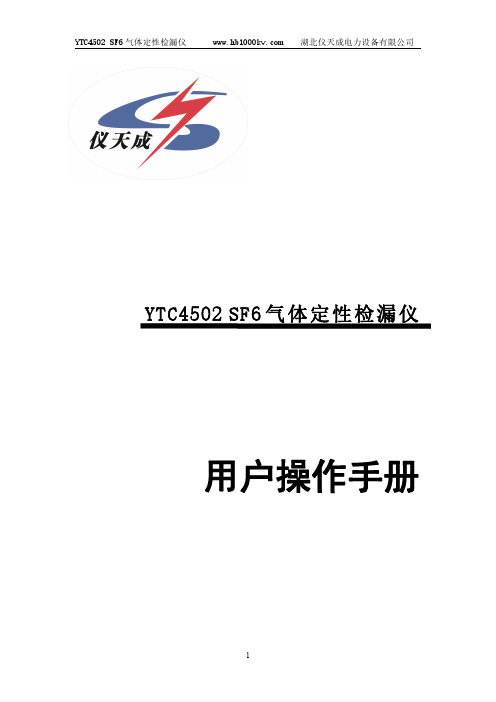
用户操作手册尊敬的顾客感谢您购买本公司YTC4502SF6气体定性检漏仪。
在您初次使用该仪器前,请您详细地阅读本使用说明书,将可帮助您熟练地使用本仪器。
我们的宗旨是不断地改进和完善公司的产品,因此您所使用的仪器可能与使用说明书有少许的差别。
如果有改动的话,我们会用附页方式告知,敬请谅解!您有不清楚之处,请与公司售后服务部联络,我们定会满足您的要求。
由于输入输出端子、测试柱等均有可能带电压,您在插拔测试线、电源插座时,会产生电火花,小心电击,避免触电危险,注意人身安全!◆慎重保证本公司生产的产品,在发货之日起三个月内,如产品出现缺陷,实行包换。
三年(包括三年)内如产品出现缺陷,实行免费维修。
三年以上如产品出现缺陷,实行有偿终身维修。
◆安全要求请阅读下列安全注意事项,以免人身伤害,并防止本产品或与其相连接的任何其它产品受到损坏。
为了避免可能发生的危险,本产品只可在规定的范围内使用。
只有合格的技术人员才可执行维修。
—防止火灾或人身伤害使用适当的电源线。
只可使用本产品专用、并且符合本产品规格的电源线。
正确地连接和断开。
当测试导线与带电端子连接时,请勿随意连接或断开测试导线。
产品接地。
本产品除通过电源线接地导线接地外,产品外壳的接地柱必须接地。
为了防止电击,接地导体必须与地面相连。
在与本产品输入或输出终端连接前,应确保本产品已正确接地。
注意所有终端的额定值。
为了防止火灾或电击危险,请注意本产品的所有额定值和标记。
在对本产品进行连接之前,请阅读本产品使用说明书,以便进一步了解有关额定值的信息。
请勿在无仪器盖板时操作。
如盖板或面板已卸下,请勿操作本产品。
使用适当的保险丝。
只可使用符合本产品规定类型和额定值的保险丝。
避免接触裸露电路和带电金属。
产品有电时,请勿触摸裸露的接点和部位。
在有可疑的故障时,请勿操作。
如怀疑本产品有损坏,请本公司维修人员进行检查,切勿继续操作。
请勿在潮湿环境下操作。
请勿在易爆环境中操作。
KIMO FG 110 便携式可燃气体测漏仪操作手册说明书

操作手册FG110便携式可燃气体测漏仪1.注意事项请在使用本产品前, 详细阅读本操作手册, 且熟悉本产品的使用操作。
请将操作手册和本产品一同存放, 方便在您需要时可随时对照查阅。
1.1 避免产品损坏或使用人员受伤:►不可将测量仪或探头和溶剂储存。
►不可在有电设备附近或上面使用测量仪或探头。
1.2 产品保修有效/ 安全须知声明:►本产品仅可在技术规格中的量程内进行测量。
►不可使用外力破坏本产品, 并依照本操作手册中的方式使用本产品。
►依照本产品技术规格内的主机或探头的操作温度范围内使用。
►除了更换测量仪的电池或操作手册中允许的部分外, 不可自行打开测量仪或探头外壳。
►产品如有任何损坏, 请与本公司售后服务部联系安排产品检修, 不可自行进行维修。
1.3 产品回收和处理声明:►将使用完的电池送至专门提供的废电池收集点回收。
►如本产品使用寿命结束后, 请将产品寄回本公司。
我们将依照WEEE (2002/96/CE) 相关规定并保护环境的方式处理您所寄回的产品。
1.4 产品用途:►KIMO 研发设计和生产的高精度便携式可燃气体测漏仪, 用于空气中可燃气体测漏。
1.5 产品禁止使用:►本产品禁止用于防爆区域。
►本产品禁止用于医疗诊断。
2.产品介绍2.1 测量仪介绍2.2 按键说明(a)液晶显示屏:数字和图形液晶显示屏(b)ON / OFF 电源开关:开启电源或关闭电源ESC 键:回到上一层菜单选项(c)HOLD 键:测量值定格min / max 键:测量最小值或最大值(d)显示屏背光键:开启或关闭显示屏背光(e)菜单选项循环键:循环显示菜单的各个选项(f)OK 键:确认(a)液晶显示屏(b)ON / OFF 电源开关ESC 键(c)HOLD 键min / max 键(d)显示屏背光键(e)菜单选项循环键(f)OK 键MAX MINAVG 3.1 开启电源按下键开启测量仪, 初始化时显示仪器型号, 热机60秒倒数后进入测量模式。
YTC4503 高精度 SF6 气体检漏仪 用户操作手册说明书
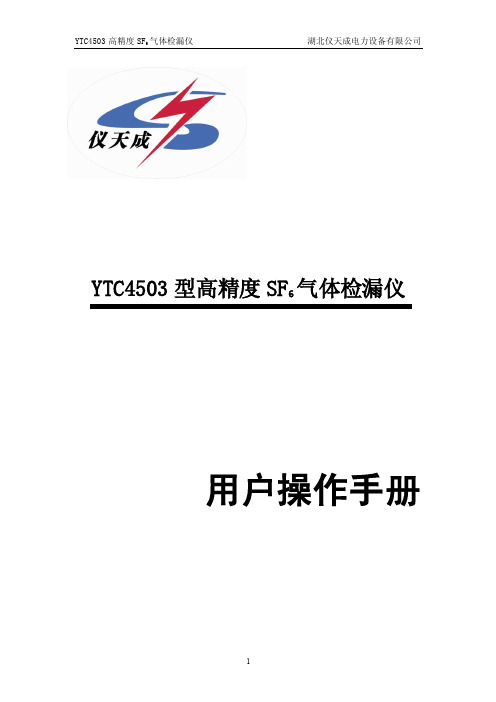
YTC4503型高精度SF6气体检漏仪用户操作手册目录一.概述 (3)二.主要技术指标 (3)三.主要特点 (4)四.操作步骤 (5)五.注意事项 (5)一.概述YTC4503型高精度SF6气体检漏仪是在电力工业部“八五”重点科研项目“SF6检漏仪质量及检漏仪的研制”的基础上根据广大用户反馈意见,结合我国电力系统的实际情况而精心设计的新一代产品。
该仪器除了克服国外产品的缺点,吸收其优点外,还具有灵敏度高、稳定性好、响应速度快、操作简便、移动范围大、可迅速、准确地定性和定量检测SF6断路器和GIS的泄漏点和年泄漏率。
本仪器系国内最先进的SF6气体检漏仪,具有国际先进水平。
仪器十分适合于供电部门.安装检修单位和电力试验研究所使用,同时也十分适合高压开关厂作为SF6电器设备入出口产品的配套仪器,从而提高了整体产品的档次。
二.主要技术指标1.最小检测值:0.01μL/L2.检测范围: 10-30μL/L100-200μL/L300-500μL/L3.响应时间: <1秒4.恢复时间: 10秒5.示值误差:≤±3%6.重复性:≤1%7.稳定性:零点漂移:<±1%量程漂移:<±1%8.指示方法:指示仪表显示和声光讯号9.探枪检测长度:5米10.连续工作时间:3小时11.仪器电源: 220V 50Hz12.使用环境:温度:5-45℃相对湿度:≤±1%13.整机重量: 26公斤三.主要特点:1、体积小,重量轻:尽最大可能采用轻质原材料,压缩仪器的空间和重量,使仪器的体积和重量大大下降,便于运输和携带。
2、测量线段长,可检测约5米高的泄漏点,移动范围大。
3、灵敏度高:在电路上采用优化设计,同时降低噪声及电磁波的干扰,使灵敏度提高。
4、测量范围宽,多档切换:仪器可在SF6开关装置的泄漏率范围内检测SF6的漏气量,可多档切换选择,并给出每档的标准曲线,能进行定量和定性检漏。
- 1、下载文档前请自行甄别文档内容的完整性,平台不提供额外的编辑、内容补充、找答案等附加服务。
- 2、"仅部分预览"的文档,不可在线预览部分如存在完整性等问题,可反馈申请退款(可完整预览的文档不适用该条件!)。
- 3、如文档侵犯您的权益,请联系客服反馈,我们会尽快为您处理(人工客服工作时间:9:00-18:30)。
用户指南
User's Guide
青岛莱特电力设备有限公司
LMR-42C
SF6气体检漏仪
感谢您选择莱特产品!
祝贺您荣为莱特用户!
莱特公司遵从可持续发展的策略,因此我们热情欢迎您对本指南中所描述的产品提出宝贵意见和建议,以利于莱特为您开发出更具先进性、适用性、可靠性的产品。
1 概述
光声光谱原理基于美国科学家贝尔电话公司的创始人BELL于1880年发现的光声效应。
接着在1943年LUFT使用光声光谱带光源测得了微量气体的吸收谱,灵敏度达到ppm级。
20世纪70年代,随着弱信号检测技术的不断积累和发展,高灵敏度微音器和压电陶瓷的出现,以及各种激光器问世,光声技术得到了重视。
尤其在微量气体检测方面,光声技术获得广泛研究与发展。
在气体检测方面,光声光谱技术的气体检测系统,是根据不同气体的吸收光谱随着气体不同而存在各自差异原理制成的。
不同的气体分子具有不同的化学结构,因而对不同波长的光声光谱辐射的吸收程度不同。
即每种气体在其光谱中,对特定波长的光有较强的吸收,通过检测气体对光的波长和强度的影响,便可确定气体的浓度。
同样吸收波长的强度与其气体浓度成正比关系。
2 工作原理
LMR-42C SF6气体检漏仪,基于光声光谱技术原理,用特定发射器发射一束单色光源,当SF6气体经过调制光源时,SF6气体吸收光能(每种气体都有自身的吸收光谱),光源波长及强度发生变化,能量的变化同时导致压力波动,这种压力波动可用微音拾音器和压电陶瓷传声器检测,并通过放大器得到光声信号,再转换成电压信号,从而得出SF6气体的浓度值。
LMR-42C SF6气体检漏仪,主要应用于电力行业GIS和SF6绝缘的断路器及SF6充气式环网柜等SF6相关产品的泄漏检测使用。
该仪器集中了多方面优点于一身,充分考虑现场应用的特点,将它设计成了重量轻、便携式、无放射源、不需氩气、快速反应、高精度和高灵敏度、不受环境气体影响的SF6检漏仪。
3 主要特点
●先进的光声光谱技术。
●无辐射,无放射源。
●低维护,无易损件。
●严重泄漏或SF6浓度达到100%时不会污染或损坏传感器。
●检测到SF6浓度高于预先设置的报警线后自动触发报警的功能。
●长期稳定,可靠,重复性高。
●随时随地可进行零点校准。
●体积小但智能化,功能齐全。
●具有数据快存储及查询功能。
●内置微型抗电磁干扰真空泵,抽取样气迅速,加快测量取样速度。
●微型抗电磁干扰真空泵可控,可随时开启测量或随时关闭。
●报警线可编程。
●带报警消音功能。
●体积小、重量轻,易操作;
●传感器寿命长达30年,校验周期长(建议5年校验一次)。
●测试速度快,耗气低,大大提高了工作效率。
●测量范围宽,精度高。
●高灵敏度,重复性好。
●不受环境温度影响。
●交直流两用,内置锂电池,待机长达48小时。
●TFT超大彩屏。
4 技术参数
●测量范围:0~1500PPM
●精度:±1PPM
●灵敏度:1ppm ,3.43克/年,1.8±10-5mbarL/s,不受其他气体
影响,不受湿度影响(1~99%RH(相对湿度)),无冷凝。
●分辨率:0.1PPM
●响应时间:≤10s
●工作温度:-40℃~80℃
●工作湿度:0~99%RH
●报警:显示屏警戒色提示
●显示方式:彩色中文
●工作电源:可充电锂电池
●探抢:手持探枪型、泵吸式取样
5 技术指标
●测量范围:0~1500 ppm
●测量精度:±1ppm
●响应时间:≤10S
●分辨率:0.1ppm
●重复性:±0.5ppm
6 产品结构
7 界面介绍
7.1 测量界面
打开仪器电源开关,屏幕显示数据测量界面,在【测量界面】中显示SF6测量值(PPM)、环境温度值(℃),如下图:
测量界面操作说明见下表:
7.2 主菜单界面
在【测量界面】下,点击菜单按钮,系统将打开【系统设置界面】,
如下图所示:
7.3 历史数据界面
在【主菜单界面】下,点击“历史数据”按钮,所有保存的数据都按时间顺序排列,如下图所示:
“打印”,可把表中数据打印出来,如下图:
7.4 系统设置界面
此界面主要是进行出厂设置,一般用户无法进入此界面,需要
工厂提供密码,如下图:
设置系统时间如下图所示:
此界面显示的S/N为厂家的仪器序列号,VER为厂家的产品版
本号。
当仪器出现故障,用户可将此信息提供给厂家,方便维护。
8 使用注意事项
●使用完毕后,关闭仪器电源,同时请拔出进气取样管道。
●使用温度在-20℃~+80℃环境下,且环境中不含有足以引起腐
蚀的气体,避免剧烈震动。
●取样管道放置时要特别小心,避免损坏液晶屏幕。
9 售后服务
9.1保修范围
仪器自购买之日起三年内保修,凡用户遵守使用规则而产品质量低于技术标准规定的,本公司负责免费维修或更换。
9.2终身维修服务
对用户保管、使用不当、自行拆装造成仪器损坏,或超出保修期的维修服务,本公司只收取维修成本费。
LMR-42C LIGHT
11。
